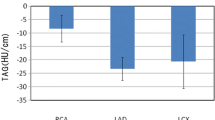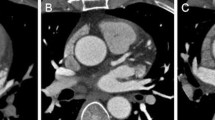Abstract
Objectives
To assess the image quality and diagnostic accuracy of 320-row area detector CT (320-ADCT) coronary angiography using 40 mL of contrast material in comparison with 60-mL protocol.
Methods
This retrospective study included 183 patients who underwent 320-ADCT coronary angiography using 40 mL of contrast and additional 183 sex- and body mass index-matched patients using 60 mL of contrast constituting the control group. Both groups used the same 5-mL/sec injection rate. Quantitative image quality measurements and diagnostic accuracies were calculated and compared.
Results
Mean attenuation and contrast-to-noise ratio (CNR) at the aorta and all coronary arteries were lower in the 40-mL group than in the 60-mL group (all, p < 0.05), except for the CNR at proximal coronary arteries at 100 kVp (p = 0.073). However, the proportion of coronary segments with vessel attenuation >250 HU was not different between groups (all, p > 0.05), except for distal coronary arteries at 80 kVp (p = 0.001). Furthermore, there were no differences in per-patient and per-segment diagnostic accuracies between the groups (all, p > 0.05).
Conclusions
320-ADCT coronary angiography using 40 mL of contrast showed image quality and diagnostic accuracy comparable to the 60-mL protocol, demonstrating the clinical feasibility of lowering the risk of contrast-induced nephropathy through contrast volume reduction.
Key points
• 320-ADCT might enable reduction of contrast material volume.
• A 40-mL contrast protocol for 320-ADCT provided acceptable image quality.
• A 40-mL contrast protocol for 320-ADCT demonstrated sufficient diagnostic accuracy.



Similar content being viewed by others
Abbreviations
- 320-ADCT:
-
320-row area detector computed tomography
- BMI:
-
Body mass index
- CIN:
-
Contrast-induced nephropathy
- CNR:
-
contrast-to-noise ratio
References
McCullough PA, Adam A, Becker CR et al (2006) Epidemiology and prognostic implications of contrast-induced nephropathy. Am J Cardiol 98:5–13
Parfrey P (2005) The clinical epidemiology of contrast-induced nephropathy. Cardiovasc Intervent Radiol 28:S3–S11
Berg KJ (2000) Nephrotoxicity related to contrast media. Scand J Urol Nephrol 34:317–322
McCullough PA, Wolyn R, Rocher LL, Levin RN, O'Neill WW (1997) Acute renal failure after coronary intervention: incidence, risk factors, and relationship to mortality. Am J Med 103:368–375
Manske CL, Sprafka JM, Strony JT, Wang Y (1990) Contrast nephropathy in azotemic diabetic patients undergoing coronary angiography. Am J Med 89:615–620
Maeder M, Klein M, Fehr T, Rickli H (2004) Contrast nephropathy: review focusing on prevention. J Am Coll Cardiol 44:1763–1771
McCullough PA, Soman SS (2005) Contrast-induced nephropathy. Crit Care Clin 21:261–280
Morcos S, Thomsen H, Webb J (1999) Contrast-media-induced nephrotoxicity: a consensus report. Eur Radiol 9:1602–1613
Rihal CS, Textor SC, Grill DE et al (2002) Incidence and prognostic importance of acute renal failure after percutaneous coronary intervention. Circulation 105:2259–2264
Freeman RV, O’Donnell M, Share D et al (2002) Nephropathy requiring dialysis after percutaneous coronary intervention and the critical role of an adjusted contrast dose. Am J Cardiol 90:1068–1073
McDonald RJ, McDonald JS, Bida JP et al (2013) Intravenous contrast material-induced nephropathy: causal or coincident phenomenon? Radiology 267:106–118
McDonald RJ, McDonald JS, Carter RE et al (2014) Risk of intravenous contrast material-mediated acute kidney injury: a propensity score-matched study stratified by baseline-estimated glomerular filtration rate. Radiology 271:65–73
Stacul F, van der Molen AJ, Reimer P et al (2011) Contrast induced nephropathy: updated ESUR contrast media safety committee guidelines. Eur Radiol 21:2527–2541
Goldenberg I, Matetzky S (2005) Nephropathy induced by contrast media: pathogenesis, risk factors and preventive strategies. CMAJ 172:1461–1471
Wintersperger BJ, Nikolaou K (2005) Basics of cardiac MDCT: techniques and contrast application. Eur Radiol 15:B2–B9
Hein PA, May J, Rogalla P, Butler C, Hamm B, Lembcke A (2010) Feasibility of contrast material volume reduction in coronary artery imaging using 320-slice volume CT. Eur Radiol 20:1337–1343
Kumamaru KK, Steigner ML, Soga S et al (2011) Coronary enhancement for prospective ECG-gated single RR axial 320-MDCT angiography: comparison of 60-and 80-mL iopamidol 370 injection. Am J Roentgenol 197:844–850
Yoo R-E, Park E-A, Lee W et al (2013) Image quality of adaptive iterative dose reduction 3D of coronary CT angiography of 640-slice CT: comparison with filtered back-projection. Int J Cardiovasc Imaging 29:669–676
Lim J, Park E-A, Lee W, Shim H, Chung JW (2015) Image quality and radiation reduction of 320-row area detector CT coronary angiography with optimal tube voltage selection and an automatic exposure control system: comparison with body mass index-adapted protocol. Int J Cardiovasc Imaging 31:23–30
Cerqueira MD, Weissman NJ, Dilsizian V et al (2002) Standardized myocardial segmentation and nomenclature for tomographic imaging of the heart a statement for healthcare professionals from the cardiac imaging committee of the Council on Clinical Cardiology of the American Heart Association. Circulation 105:539–542
Becker CR, Hong C, Knez A et al (2003) Optimal contrast application for cardiac 4-detector-row computed tomography. Invest Radiol 38:690–694
Johnson PT, Pannu HK, Fishman EK (2009) IV contrast infusion for coronary artery CT angiography: literature review and results of a nationwide survey. Am J Roentgenol 192:W214–W221
Liang KY, Zeger SL (1986) Longitudinal data analysis using generalized linear models. Biometrika 73:13–22
Lembcke A, Schwenke C, Hein PA et al (2014) High-pitch dual-source CT coronary angiography with low volumes of contrast medium. Eur Radiol 24:120–127
Wang Z, Chen Y, Wang Y et al (2014) Feasibility of low-dose contrast medium high pitch CT angiography for the combined evaluation of coronary, head and neck arteries. PLoS One 9, e90268
Weigold WG, Olszewski ME, Walker MJ (2009) Low-dose prospectively gated 256-slice coronary computed tomographic angiography. Int J Cardiovasc Imaging 25:217–230
Yamamuro M, Tadamura E, Kanao S et al (2007) Coronary angiography by 64-detector row computed tomography using low dose of contrast material with saline chaser: influence of total injection volume on vessel attenuation. J Comput Assist Tomogr 31:272–280
Tatsugami F, Matsuki M, Inada Y et al (2010) Feasibility of low-volume injections of contrast material with a body weight–adapted iodine-dose protocol in 320-detector row coronary CT angiography. Acad Radiol 17:207–211
Mahnken AH, Rauscher A, Klotz E et al (2007) Quantitative prediction of contrast enhancement from test bolus data in cardiac MSCT. Eur Radiol 17:1310–1319
Silverman PM, Roberts S, Tefft MC et al (1995) Helical CT of the liver: clinical application of an automated computer technique, SmartPrep, for obtaining images with optimal contrast enhancement. Am J Roentgenol 165:73–78
Bae KT, Seeck BA, Hildebolt CF et al (2008) Contrast enhancement in cardiovascular MDCT: effect of body weight, height, body surface area, body mass index, and obesity. Am J Roentgenol 190:777–784
Fleischmann D (2005) How to design injection protocols for multiple detector-row CT angiography (MDCTA). Eur Radiol 15:E60–E65
Cademartiri F, Mollet NR, Runza G et al (2005) Influence of intracoronary attenuation on coronary plaque measurements using multislice computed tomography: observations in an ex vivo model of coronary computed tomography angiography. Eur Radiol 15:1426–1431
Malayeri AA, Zimmerman SL, Lake ST, Fishman EK, Johnson PT (2014) 128-Slice dual source coronary CTA: defining optimal arterial enhancement levels. Emerg Radiol 21:499–504
Zhang LJ, Wang Y, Schoepf UJ et al (2015) Image quality, radiation dose, and diagnostic accuracy of prospectively ECG-triggered high-pitch coronary CT angiography at 70 kVp in a clinical setting: comparison with invasive coronary angiography. Eur Radiol. doi:10.1007/s00330-015-3868-z
Kok M, Turek J, Mihl C et al (2015) Low contrast media volume in pre-TAVI CT examinations. Eur Radiol. doi:10.1007/s00330-015-4080-x
Zhu X, Zhu Y, Xu H, Tang L, Xu Y (2012) The influence of body mass index and gender on coronary arterial attenuation with fixed iodine load per body weight at dual-source CT coronary angiography. Acta Radiol 53:637–642
Acknowledgments
We would like to acknowledge Ms. Hyunsook Hong from the medical research collaborating center of our institution for her assistance with the statistical analysis. The scientific guarantor of this publication is Jin Wook Chung.
The authors of this manuscript declare no relationships with any companies whose products or services may be related to the subject matter of the article. The authors state that this work has not received any funding. Institutional review board approval was obtained. Written informed consent was waived by the institutional review board. Methodology: retrospective, case-control study, performed at one institution.
Author information
Authors and Affiliations
Corresponding author
Rights and permissions
About this article
Cite this article
Kim, R., Park, EA., Lee, W. et al. Feasibility of 320-row area detector CT coronary angiography using 40 mL of contrast material: assessment of image quality and diagnostic accuracy. Eur Radiol 26, 3802–3810 (2016). https://doi.org/10.1007/s00330-016-4275-9
Received:
Revised:
Accepted:
Published:
Issue Date:
DOI: https://doi.org/10.1007/s00330-016-4275-9




